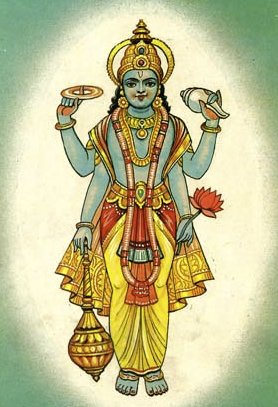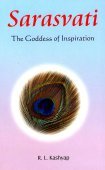Triloka, Tri-loka: 12 definitions
Introduction:
Triloka means something in Buddhism, Pali, Hinduism, Sanskrit. If you want to know the exact meaning, history, etymology or English translation of this term then check out the descriptions on this page. Add your comment or reference to a book if you want to contribute to this summary article.
In Hinduism
Kosha (encyclopedic lexicons)
Source: Google Books: Kalātattvakośa, volume 2Triloka (त्रिलोक).—The conception of the triloka—earth, mid-space and heaven, or nether-world, earth and heaven—has been depicted in the figure of Viṣṇu Trivikrama (-> krama), who with his three steps covers all the three worlds. In sculpture he is represented with one foot stepping firmly on the earth, or pressing down the demon-king Bali in the nether-world, and the other foot raised high to indicate his highest step (parama pada). The third, or rather intermediary step is not visible. In painting, however, we find an exceptional image of Trivikrama showing him with three legs.
Kosha (कोश, kośa) refers to Sanskrit lexicons intended to provide additional information regarding technical terms used in religion, philosophy and the various sciences (shastra). The oldest extant thesaurus (kosha) dates to the 4th century AD.
Vaishnavism (Vaishava dharma)
Source: ISKCON Press: GlossaryTriloka (त्रिलोक).—The Sanskrit term tri-loka is often found in Vedic scriptures. Tri-loka means three worlds. The universe is divided into three worlds, or realms of consciousness: bhūr, bhuvaḥ and svaḥ (the gross region, the subtle region and the celestial region).

Vaishnava (वैष्णव, vaiṣṇava) or vaishnavism (vaiṣṇavism) represents a tradition of Hinduism worshipping Vishnu as the supreme Lord. Similar to the Shaktism and Shaivism traditions, Vaishnavism also developed as an individual movement, famous for its exposition of the dashavatara (‘ten avatars of Vishnu’).
Purana and Itihasa (epic history)
Source: Cologne Digital Sanskrit Dictionaries: The Purana IndexTriloka (त्रिलोक).—Progress of, depends on the sun without which there would be no reckoning of time and nothing would go on.*
- * Vāyu-purāṇa 50. 60; 53. 34-41.

The Purana (पुराण, purāṇas) refers to Sanskrit literature preserving ancient India’s vast cultural history, including historical legends, religious ceremonies, various arts and sciences. The eighteen mahapuranas total over 400,000 shlokas (metrical couplets) and date to at least several centuries BCE.
Shaktism (Shakta philosophy)
Source: Google Books: ManthanabhairavatantramTriloka (त्रिलोक) refers to the “three worlds”, according to the Kularatnapañcakāvatāra verse 1.23cd-33ab.—Accordingly, “Sound, touch, form, flavour, smell, mind, intellect, ego, and Karma, which is considered to be the ninth—the goddess has assumed nine aspects and (she is) my pervasive power. She brings about (this) multifarious wonder in the three worlds (triloka—triṣu lokeṣu) by means of (her) Māyā. Due to (that) will, which is supreme and most inferior, the entire universe is pervaded by these (nine). O dear one, pleasure and pain arise and fall away. [...]”.

Shakta (शाक्त, śākta) or Shaktism (śāktism) represents a tradition of Hinduism where the Goddess (Devi) is revered and worshipped. Shakta literature includes a range of scriptures, including various Agamas and Tantras, although its roots may be traced back to the Vedas.
In Buddhism
General definition (in Buddhism)
Source: Buddhist Door: Glossarysee Three Realms.Languages of India and abroad
Sanskrit dictionary
Source: DDSA: The practical Sanskrit-English dictionaryTriloka (त्रिलोक).—the three worlds.
-kaḥ an inhabitant of the three worlds; यद्धर्मसूनोर्बत राजसूये निरीक्ष्य दृक्स्वस्त्ययनं त्रिलोकः (yaddharmasūnorbata rājasūye nirīkṣya dṛksvastyayanaṃ trilokaḥ) Bhāgavata 3. 2.13. °आत्मन् (ātman) m. the Supreme Being. °ईशः (īśaḥ) the sun. °नाथः (nāthaḥ) 'lord of the three worlds', an epithet of
Derivable forms: trilokam (त्रिलोकम्).
Triloka is a Sanskrit compound consisting of the terms tri and loka (लोक).
Source: Cologne Digital Sanskrit Dictionaries: Benfey Sanskrit-English DictionaryTriloka (त्रिलोक).—I. (n), and f. kī, the three worlds, Mahābhārata 13, 1505; [Rāmāyaṇa] 3, 52, 22; [Bhāgavata-Purāṇa, (ed. Burnouf.)] 1, 5, 7. Ii. m. ºka, the inhabitants of the three worlds, ib. 3, 2, 13.
Triloka is a Sanskrit compound consisting of the terms tri and loka (लोक).
Source: Cologne Digital Sanskrit Dictionaries: Cappeller Sanskrit-English DictionaryTriloka (त्रिलोक).—[neuter] (only °—& [locative]), ī [feminine], & [masculine] [plural] the three worlds (cf. tribhuvana).
Source: Cologne Digital Sanskrit Dictionaries: Monier-Williams Sanskrit-English Dictionary1) Triloka (त्रिलोक):—[=tri-loka] [from tri] n. sg. ([Mahābhārata xiii; Harivaṃśa 11303]) m. [plural] ([Rāmāyaṇa iii]) the 3 worlds (= -patha)
2) [v.s. ...] m. sg. the inhabitants of the 3 worlds, [Bhāgavata-purāṇa iii, 2, 13]
[Sanskrit to German]
Sanskrit, also spelled संस्कृतम् (saṃskṛtam), is an ancient language of India commonly seen as the grandmother of the Indo-European language family (even English!). Closely allied with Prakrit and Pali, Sanskrit is more exhaustive in both grammar and terms and has the most extensive collection of literature in the world, greatly surpassing its sister-languages Greek and Latin.
Kannada-English dictionary
Source: Alar: Kannada-English corpusTrilōka (ತ್ರಿಲೋಕ):—[noun] the three worlds, the physical world, lower region and the heaven.
--- OR ---
Triḷōka (ತ್ರಿಳೋಕ):—[noun] = ತ್ರಿಲೋಕ [triloka].
Kannada is a Dravidian language (as opposed to the Indo-European language family) mainly spoken in the southwestern region of India.
See also (Relevant definitions)
Starts with (+2): Trilokacandra, Trilokadarpanakatha, Trilokadhipati, Trilokadipika, Trilokajanani, Trilokaka, Trilokakarana, Trilokakrit, Trilokanatha, Trilokapati, Trilokaprajnapti, Trilokarakshin, Trilokasandarshana, Trilokasandarshanalokeshvara, Trilokasara, Trilokastha, Trilokatman, Trilokavana, Trilokavashamkara, Trilokavira.
Ends with: Bhartriloka, Pitriloka, Ratriloka, Striloka.
Full-text (+6): Trailokya, Trailoka, Triloki, Trilokesha, Trilokasara, Trilokavashamkara, Trilokavira, Trilokarakshin, Trilokanatha, Tirilokatipati, Trilokatman, Trailaukika, Traivargika, Tri, Tirilokam, Natha, Narada, Trilokaka, Avana, Vijayin.
Relevant text
Search found 11 books and stories containing Triloka, Tri-loka, Trilōka, Tri-lōka, Triḷōka; (plurals include: Trilokas, lokas, Trilōkas, lōkas, Triḷōkas). You can also click to the full overview containing English textual excerpts. Below are direct links for the most relevant articles:
Garga Samhita (English) (by Danavir Goswami)
Verse 8.13.64 < [Chapter 13 - A Thousand Names of Lord Balarāma]
Chaitanya Bhagavata (by Bhumipati Dāsa)
Verse 2.7.98 < [Chapter 7 - The Meeting of Gadādhara and Puṇḍarīka]
Jainism and Patanjali Yoga (Comparative Study) (by Deepak bagadia)
Part 5.6 - Tattvarthasutra: the summary of Agamas < [Chapter 3 - Jain Philosophy and Practice]
Part 2.1 - Right perception (samyak darsana) < [Chapter 3 - Jain Philosophy and Practice]
Part 7 - Patanjali’s Ashtanga Yoga compared to Jainism < [Chapter 4 - A Comparative Study]
The Devi Bhagavata Purana (by Swami Vijñanananda)
Chapter 23 - On the prowess of Kauśikī < [Book 5]
Chapter 19 - On the narrative of the Atala, etc. < [Book 8]
Chapter 2 - On the uplifting of the Earth by the Sacrificial Boar < [Book 8]
Puranic encyclopaedia (by Vettam Mani)
Related products
